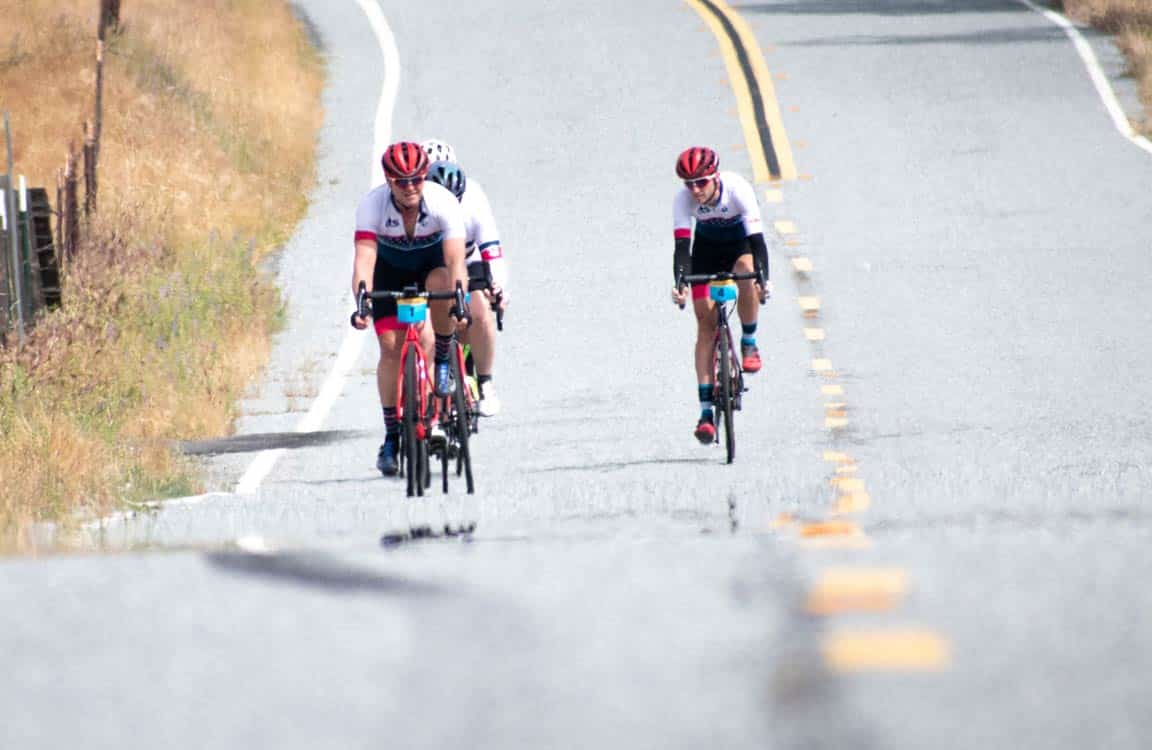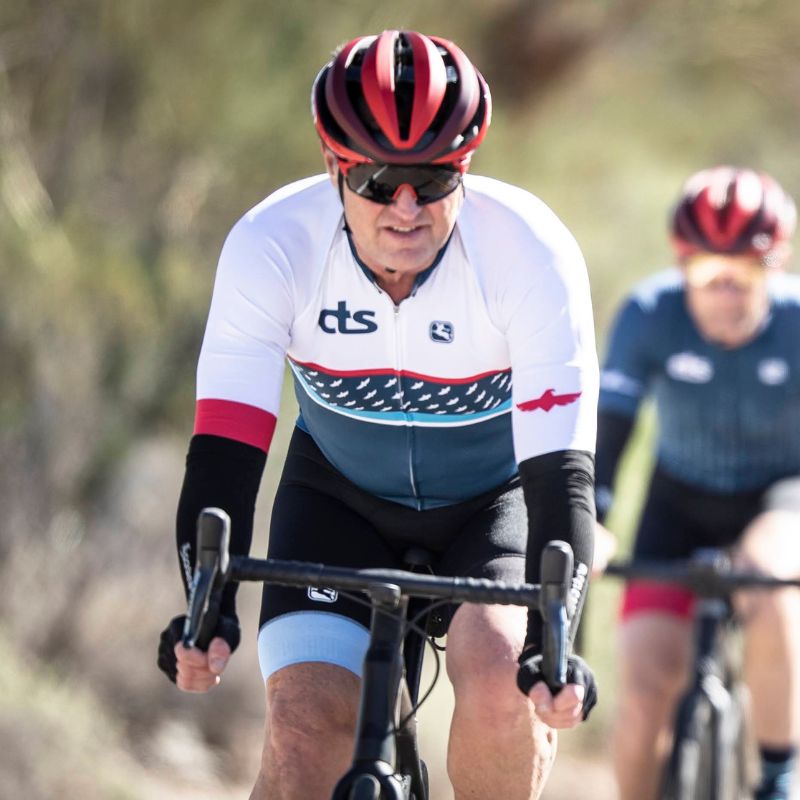
Masters Athletes Hurt More by Heat Stress. Here’s What Aging Athletes Can Do About It.
By Chris Carmichael,
CEO/Head Coach of CTS
Maintaining body temperature within a narrow range (97-99 degrees Fahrenheit) is not an easy feat for humans, particularly when you consider all the things that can push body temperature up or down, including air temperature, humidity, clothing layers, medications, dehydration, body size, and exertion. We also have to add age to the equation, because our response to heat stress changes throughout our lifespan. For athletes in the 50-70 year range, here are some things to keep in mind when training in the heat.
How Age Affects Heat Loss
Babies, children, and the elderly are at greater risk for heat-related illnesses compared to young and middle-aged adults. In the early years, babies and children have less skin surface area available for evaporative cooling (sweating), so in hot environments they can store a lot of heat and struggle to get rid of it. In addition, children – especially very young children – often lack the ability, autonomy, or understanding to move out of a hot environment, remove clothing layers, or reduce activity level.
On the other end of the spectrum, the elderly can also be at greater risk for heat illness due to a lack of mobility, but even physically active older adults suffer more than younger adults in the heat. In response to passive exposure to a hot environment (not exercising) for 3 hours, a 2016 study showed that both younger (19-28yrs) and older (55-73yrs) groups responded similarly in the first hour, but that the older group stored more heat (heat loss decreased) as time went on. They cited reduced blood perfusion to the limbs as a potential limiting factor for evaporative cooling in the older group.
Reduced sweat response in older athletes was also observed in another 2016 study that examined sympathetic nervous system activity in response to heat. They found that older adults (67yrs) had a reduced vasodilation reflex in the skin compared to younger adults (23yrs), meaning both groups responded to heat exposure by dilating blood vessels in the skin, but that reflex was blunted in aged skin.
Feel Stronger in 6 Weeks — No Matter Your Age
Climbs feel steeper? Recovery slower?
You’re not done getting faster — you just need a smarter plan.
The 6-Week Masters Power Build Coaching Program is designed for cyclists 50+ who want to boost power, recover faster, and ride stronger — all with expert 1:1 coaching.
- Personalized 6-Week Training Plan
- 1:1 Coaching + TrainingPeaks Premium
- Mobility & Strength Bonus Guides
💪 Guarantee: Stronger or free.
Start your 6-week journey for $149How fitness Affects Heat Loss
I’ve previously written about the fact people start sweating earlier, more profusely, and from more areas of their skin as a response to increased fitness. This is one of the key adaptations to being more active. As you increase the amount of work – and therefore the amount of heat – you can generate in a given time, your body ramps up its cooling mechanisms to be ready for the demand.
Body mass also plays a role in heat loss. Both overweight non-athletes and athletes store more heat compared to smaller individuals. This has been researched by militaries, as they try to adapt training methods for larger recruits. Cooling a larger body also puts more strain on the cardiovascular system because there are more blood vessels perfusing more skin surface area.
Older Athletes are More Vulnerable to Heat Storage
In older athletes, fitness improves “sweat efficiency” compared to sedentary older people, but not to the same extent as it does for younger athletes. So, similar to the way VO2 max gradually declines through the decades after 40, your fitness-related adaptation to sweat response diminishes as well.
A 2015 study looked at younger (27yrs) and older (57yrs) firefighters, as well as non-firefighters of similar age (53yrs) and concluded that both the older groups stored more heat during intermittent exercise compared to the younger group, but the older non-firefighters stored significantly more heat than the older figherfighters.
Similarly, another 2015 study of female athletes showed the older group (58yrs) dissipated less heat through sweating compared to the younger group (23yrs). In this study, the subjects were matched for skin surface area and fitness level (VO2 max), which wasn’t the case for the firefighter study. Interestingly, as exercise workload – and therefore heat generated – increased, the differences between the groups’ responses grew.
► Free Cycling Training Assessment Quiz
Take our free 2-minute quiz to discover how effective your training is and get recommendations for how you can improve.
Heat-related Advice for Older Athletes
If you are over 50 and feel like you’re less tolerant than you used to be of moderate- to high-intensity exercise on hot days, you’re probably right. There is a lot of personal variability involved, too, meaning heat tolerance or performance in heat changes differently for different athletes. Nevertheless, here’s what athletes over 50 should do:
Stay on top of Hydration status
Dehydration hurts performance for everyone, but for older athletes who are likely to store more heat and have a diminished sweat response, staying hydrated becomes even more important.
Check Your Medications
Some medications can affect your ability to deal with heat. Beta blockers, for instance, slow a person’s heart rate, which can make it harder for the circulatory system to move heat to the skin. Some antihistamines and antidepressants can hinder sweating. Consult your physician to review your medications and see whether they may affect your heat or sun sensitivity.
Lose weight (if applicable)
If you are overweight and fit – as many cyclists over 50 are – losing some weight can help improve your heat tolerance. First of all, you won’t have to work as hard to maintain a given pace – particularly uphill. You’ll also have less insulation to keep the heat in, and greater “sweat efficiency” to move the heat out.
Be More Heat Conscious
Most of the habits and behaviors that work for younger adults are also essential for older adults, but it is important for athletes over 50 to recognize they are more vulnerable to heat stress and need to be more conscious of their habits in the heat. Exercising at cooler parts of the day, wearing summer-weight apparel, and dousing the head and body with water are all good recommendations for athletes of all ages. Here are four articles related to the science of exercise and performance in the heat:
- Heat Illness and Endurance Athletes: The Science of Staying Safe When It Gets Hot
- Beat the Heat Series: How to Prepare for Exercising in the Heat
- Beat the Heat Series: PERFORM at Your Best During Hot Weather Exercise
- Beat the Heat Series: Hydration and Cooling Strategies to RECOVER After Exercise in Heat
► FREE Mini-Course: Learn How to Maximize Your Limited Training Time
Learn step-by-step how to overcome limited training time and get faster. Walk away with a personalized plan to increase your performance.
"*" indicates required fields


Comments 17
Pingback: Extreme Temperature Conditions and its implications for Hockey – LX Hockey Club
Pingback: Heat Stress
High humidity makes it more difficult to stay cool, as we all know that cooling occurs when our sweat evaporates off the skin. With hi humidity the sweat doesn’t evaporate. We stay wet. IMO, when we’re soaked head to toe in high humidity the sweat actually acts like insulation. Keeping the heat in. 😢
One reads a lot of advice about training when it’s cool. However my event rides are always in the hottest part of the year. Thus I make it a point to do the opposite and try to train in the hottest part of the day. Training in the heat releases a heat stress protein which helps your body deal with it better. Finnish people who sauna every day got rid of heat better than did non-sauna folks. Twice a week was not found to help. Has to be frequent exercise in the heat. Skin-tight jerseys made from technical fabric are a big help. Underlayers are a disaster.
Pingback: Ultramarathon Daily News | Mon, June 10 | Ultrarunnerpodcast.com
Please send a copy to USACycling. I did 60+ National RR in St. Louis in 100degrees… ( I DNF as I overheated to a delirious state) back in 2012. Many older athletes DNF or were barely able to function after the race. Then again in 2015 they held the National Maratho n MTB championship in Augusta, Ga in extreme 95degree heat. Although I finished just missing the podium, I had a very difficult time after 4.5hrs in the heat.
Great post. I’d add that women have their own unique requirements when it comes to hydration (and nutrition, for that matter). It is important to consider the different hormonal phases and their impact on sodium concentration/retention in the body so that we can tailor our hydration accordingly.
I found this information very informative. At 72 yrs of age, an arithmia condition and never feeling thirsty; I’ve suffered from dehydration that has led to severe irregularities in heart beat and hospitalization. These episodes are long past, after an intern in an ER suggested times drinking. Either pick an elapsed time frame or milage marker and drink. It has worked. I use 5 mile mark and drink. Haven’t had an episode now in over 20 years.
Thanks
D. Young
One important point: you SHOULDN’T DOUSE YOURSELF with water in high humidity as it will tend to block your pores and therefore be life threatening. There’s a name for the condition, which escapes me. Also an ice and sugar slurry may lower core temp.
To Bill Dunn: That is totally the opposite of my experience and practice. Curious if you have any expert link for that. Thanks.
Here’s one article talking about the condition I read about in an article by Gina Kolkata about exercise in heat and humid conditions.
https://www.sweathelp.org/where-do-you-sweat/other-sweating/anhidrosis-no-sweating.html
hidromeiosis Is the term used and the one to look up. That’s from this article – which may be the one I remember reading:
http://mcwsxcrunningteam.blogspot.com/2016/07/running-in-heat-and-humidity.html?m=1
Something to consider anyway.
Thanks Bill. Got me thinking…
Does having ice water while riding help cool an individual or does that even matter?
I’m sure it can help some, but ev n better is a “slurpee” type drink because it can reach temps below 32 degrees. That is, an ice slurry with some kind of sugar addition.
Cold water will shunt blood away from stomach and some organs which would allow more from heat dissipation at the skin. A beneficial effect while exercising.
Cold water will shunt blood away from stomach and some organs which would allow more for heat dissipation at the skin. A beneficial effect while exercising.
The explanation that babies store more heat due to small surface area is incorrect. Heat dissipation is proportional to area, but heat generation and storage is proportional to volume. Area goes as the square of size and volume goes as the cube. Babies do have less surface area than adults, but even less volume, so will loose heat more quickly based on area/volume. Of course babies are not perfectly scaled down adults so area/volume does not scale perfectly either. Babies may be less tolerant of heat than adults, but their greater area/mass helps them in this regard.